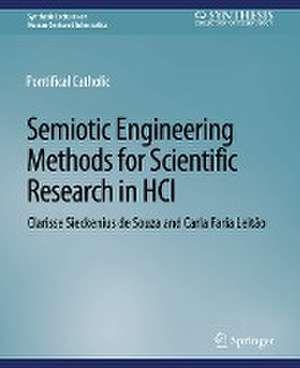Semiotic Engineering Methods for Scientific Research in HCI: Synthesis Lectures on Human-Centered Informatics
Autor Clarisse Sieckenius de Souza, Carla Faria Leitãoen Limba Engleză Paperback – 13 mar 2009
Din seria Synthesis Lectures on Human-Centered Informatics
- 20%
 Preț: 166.09 lei
Preț: 166.09 lei - 20%
 Preț: 136.65 lei
Preț: 136.65 lei - 20%
 Preț: 140.75 lei
Preț: 140.75 lei - 20%
 Preț: 160.87 lei
Preț: 160.87 lei -
 Preț: 303.06 lei
Preț: 303.06 lei - 20%
 Preț: 289.49 lei
Preț: 289.49 lei - 20%
 Preț: 301.96 lei
Preț: 301.96 lei - 20%
 Preț: 353.93 lei
Preț: 353.93 lei - 20%
 Preț: 178.13 lei
Preț: 178.13 lei - 20%
 Preț: 352.89 lei
Preț: 352.89 lei - 20%
 Preț: 481.31 lei
Preț: 481.31 lei - 20%
 Preț: 332.71 lei
Preț: 332.71 lei - 20%
 Preț: 297.66 lei
Preț: 297.66 lei - 20%
 Preț: 176.97 lei
Preț: 176.97 lei - 20%
 Preț: 134.97 lei
Preț: 134.97 lei - 20%
 Preț: 270.19 lei
Preț: 270.19 lei - 20%
 Preț: 225.67 lei
Preț: 225.67 lei - 20%
 Preț: 165.90 lei
Preț: 165.90 lei - 20%
 Preț: 328.09 lei
Preț: 328.09 lei - 20%
 Preț: 224.18 lei
Preț: 224.18 lei - 20%
 Preț: 356.56 lei
Preț: 356.56 lei - 20%
 Preț: 359.03 lei
Preț: 359.03 lei - 20%
 Preț: 167.58 lei
Preț: 167.58 lei - 20%
 Preț: 385.83 lei
Preț: 385.83 lei - 20%
 Preț: 223.67 lei
Preț: 223.67 lei - 20%
 Preț: 224.97 lei
Preț: 224.97 lei - 20%
 Preț: 193.11 lei
Preț: 193.11 lei - 20%
 Preț: 157.28 lei
Preț: 157.28 lei - 20%
 Preț: 304.30 lei
Preț: 304.30 lei - 20%
 Preț: 179.11 lei
Preț: 179.11 lei - 20%
 Preț: 173.58 lei
Preț: 173.58 lei - 20%
 Preț: 381.55 lei
Preț: 381.55 lei - 20%
 Preț: 351.94 lei
Preț: 351.94 lei - 20%
 Preț: 134.97 lei
Preț: 134.97 lei - 20%
 Preț: 388.65 lei
Preț: 388.65 lei - 20%
 Preț: 271.34 lei
Preț: 271.34 lei - 20%
 Preț: 223.01 lei
Preț: 223.01 lei - 20%
 Preț: 357.58 lei
Preț: 357.58 lei - 20%
 Preț: 300.78 lei
Preț: 300.78 lei - 20%
 Preț: 178.64 lei
Preț: 178.64 lei - 20%
 Preț: 275.79 lei
Preț: 275.79 lei - 20%
 Preț: 268.04 lei
Preț: 268.04 lei - 20%
 Preț: 301.63 lei
Preț: 301.63 lei - 20%
 Preț: 196.70 lei
Preț: 196.70 lei - 20%
 Preț: 166.59 lei
Preț: 166.59 lei
Preț: 179.61 lei
Preț vechi: 224.52 lei
-20% Nou
Puncte Express: 269
Preț estimativ în valută:
34.37€ • 35.96$ • 28.55£
34.37€ • 35.96$ • 28.55£
Carte tipărită la comandă
Livrare economică 03-17 aprilie
Preluare comenzi: 021 569.72.76
Specificații
ISBN-13: 9783031010576
ISBN-10: 3031010574
Ilustrații: XII, 121 p.
Dimensiuni: 191 x 235 mm
Greutate: 0.25 kg
Editura: Springer International Publishing
Colecția Springer
Seria Synthesis Lectures on Human-Centered Informatics
Locul publicării:Cham, Switzerland
ISBN-10: 3031010574
Ilustrații: XII, 121 p.
Dimensiuni: 191 x 235 mm
Greutate: 0.25 kg
Editura: Springer International Publishing
Colecția Springer
Seria Synthesis Lectures on Human-Centered Informatics
Locul publicării:Cham, Switzerland
Cuprins
Introduction.- Essence of Semiotic Engineering.- Semiotic Engineering Methods.- Case Study with Audacity.- Lessons Learned with Semiotic Engineering Methods.- The Near Future of Semiotic Engineering.
Notă biografică
Clarisse Sieckenius de Souza is a professor at the Department of Informatics of Pontifical Catholic University of Rio de Janeiro (PUC-Rio). With a Ph.D. in applied linguistics, she started in computer science doing research in natural language processing and text generation. She gradually moved from artificial intelligence into HCI, switching her interdisciplinary base from linguistics to semiotics. She is the founder and principle investigator of the Semiotic Engineering Research Group (SERG) at PUC-Rio, which produced the most comprehensive semiotic account of HCI in Informatics to date.Carla Faria Leitao is a senior researcher of SERG at PUC-Rio. She has a Ph.D. in clinical psychology and has been drawn to informatics and HCI by the subjective aspects of computer artifacts exposed and explored by semiotic engineering. With a special interest in how qualitative methods can be used outside the social and human sciences, she has been leading methodological research in SERG since 2002.
